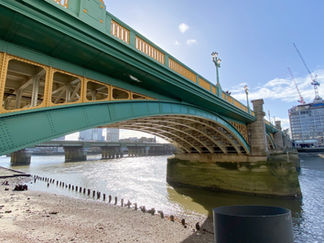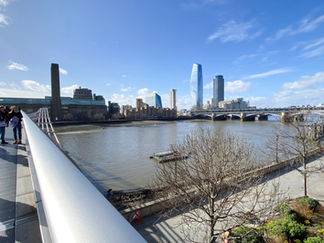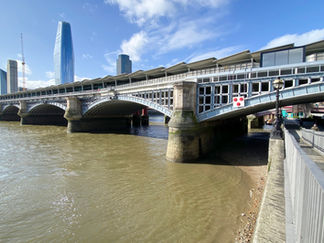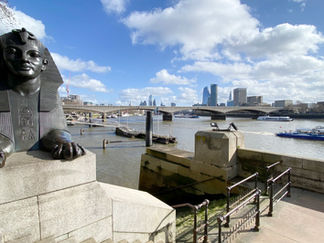London Bridge to Barnes Bridge – North Bank – March 1st 2020
The Route
This section starts from the north bank of the river at London Bridge and stays on this side of the river all the way to Barnes Bridge. It passes through the City and on to central London and takes in many of London’s landmark buildings. To the west, the path continues through Chelsea, Fulham, Hammersmith and Chiswick, finishing at Barnes Bridge.
This section is meant to be about 14 miles.
My Walk
This was the middle section of the north bank route through London. There has to be a good reason why I did it in March but for the life of me I can’t remember that reason. Also, when I set off on that sunny Sunday, I hadn’t decided where I’d finish; I thought I’d just keep going until I’d had enough.
So, I got the train from Huntingdon to Kings Cross as normal, then the Northern Line to Bank. I could have gone to London Bridge of course but the station is on the south bank. From Bank station I did the short walk down to London Bridge and the start proper of today’s walk.
In less than a mile, the path passed Cannon Street Railway Bridge, Southwark Bridge, The Millennium Bridge, Blackfriars Railway Bridge and Blackfriars Bridge. As mentioned before, walking on the opposite bank lets you see landmarks from a different perspective. From the north bank I got a better idea of the scale of the Tate Modern building. Continuing along the Embankment down to Westminster Bridge, the walk took me past more landmarks like Somerset House, the Savoy Hotel, Cleopatra’s Needle and New Scotland Yard, as well as passing under Waterloo Bridge, Hungerford Railway Bridge and the 2 Golden Jubilee footbridges. There were great views looking back towards St Paul’s and the skyscrapers of the City. Looking across to the south bank, the London Eye took centre stage of course as well as County Hall.
At Westminster Bridge, the path continued into Parliament Square. In the centre is a large open green area that contains twelve statues of statesmen and other notable individuals, including Nelson Mandela and Winston Churchill. Big Ben and its tower (officially called the Elizabeth Tower) have been shrouded in scaffolding since 2017 for a total top to bottom restoration. The work is due to be complete by the end of 2021. Past the Houses of Parliament, the path returned to the riverside through Victoria Tower Gardens. Crossing the road at Lambeth Bridge and continuing along Millbank down to Vauxhall Bridge, I passed Tate Britain. Looking across the river at Vauxhall I got a better idea of the scale of the MI6 building.
At Vauxhall Bridge the path very briefly took to the streets. Back on the riverside, the huge Battersea Power Station redevelopment filled a sizeable part of the south bank. Grosvenor Bridge (AKA Victoria Railway Bridge) came up next. This is a wide railway bridge with 10 tracks running into and out of Victoria station. In less than 200 yards, I came to Chelsea Bridge. Continuing along Chelsea Embankment, I passed the Royal Hospital Chelsea on my right. This is famous of course as the home of the Chelsea Pensioners. The South Grounds are also home to the annual RHS Chelsea Flower Show. On the south bank I could see Battersea Park and the London Peace Pagoda that I walked past on my very first walk in January.
Albert Bridge, one of the most attractive of the bridges in London came next, followed by Battersea Bridge. Soon after this, the path left the riverside briefly and took me into Lots Road. Having been a London Underground nerd for over 50 years, I knew this was famous for the Lots Road Power Station. The Lots Road station was built in 1904 and was known as “The Nerve Centre of London’s Underground”, providing power to most of the network until 1990. It was the longest-serving power station in the world when finally decommissioned in 2002. Two of its original four chimneys have survived, and at 275 feet were the tallest in Europe when built. Today, the former power station is at the centre of a swanky new riverside residential development called Chelsea Waterfront. Shops, restaurants and a health club are also included. Construction is still continuing.
Next to Chelsea Waterfront is the Chelsea Harbour development, comprising luxury apartments, the Chelsea Harbour Marina, the Chelsea Harbour Design Centre and the Chelsea Harbour Hotel. The path returned to the riverside here, on its way to Wandsworth Bridge – surely the least attractive of London’s bridges. All the way to Wandsworth were modern apartment blocks – not at all inspiring. Shortly before the bridge, the path left the riverside and continued through the streets of Fulham before rejoining at Fulham Railway Bridge and Putney Bridge.
From Putney Bridge, the path got noticeably busier with people out enjoying a sunny Sunday afternoon. Continuing alongside the river through Bishop’s Park, the path came to an abrupt end at Craven Cottage, home of Fulham Football Club. The name Riverside Stand is highly appropriate for the stand currently being rebuilt to increase ground capacity! The path turned to the right here to walk alongside the perimeter of the ground. I passed the statue of Johnny Haynes, Fulham’s most famous player, outside the stand that bears his name. After rejoining the riverside, the path continued towards Hammersmith Bridge. Looking across to the south bank, I passed the former Harrods Furniture Depository, now the centrepiece of yet another residential development.
At Hammersmith Bridge I was still going strong, so decided to continue. At the time of my walk the bridge was only open to pedestrians and cyclists but now is completely closed due to structural issues. Beyond Hammersmith, the path carried on alongside the river through a green public space called Furnivall Gardens. It then left the river once again and continued along first Upper Mall and then Chiswick Mall. These are narrow residential streets running parallel to the river and have some seriously expensive houses overlooking the river. A blackboard sign “Fuller’s Brewery Shop” with an arrow caught my attention, so I just had to leave the path to investigate further. I was at the spiritual home of London Pride and ESB – the Griffin Brewery! Sadly, everything was closed.
Back on the path, the next mile was alongside the river, with the ubiquitous modern apartment blocks to my right. Just before Barnes Bridge, the path entered Dukes Meadows, a large riverside park. At the end of the park I arrived at Barnes Bridge and decided to call it a day. Barnes Bridge is a combined railway and pedestrian bridge. Barnes Bridge railway station is on the other side of the river. I intended to get a train back into London, so crossed over the bridge. I had a 50 minute wait for the next train, so being impatient I got a bus instead to Hammersmith, followed by the tube to Kings Cross.
A very enjoyable walk. My Fitbit told me I walked nearly 18 miles.
Gallery


























